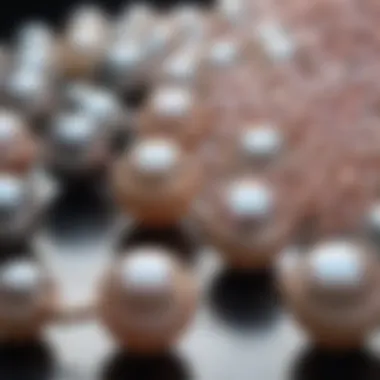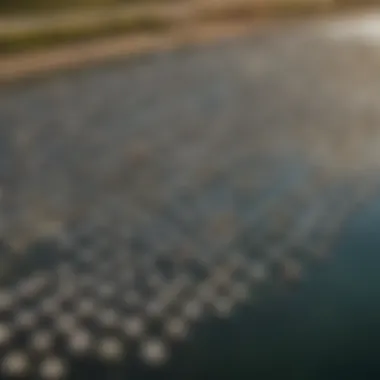Understanding Farmed Pearls: Their Production and Value


Intro
Farmed pearls have gained popularity in the world of gemstones and jewelry design. Unlike natural pearls, which are formed without human intervention, farmed pearls are cultivated through specific processes initiated by pearl farmers. Understanding the production, valuation, and cultural significance of these pearls not only illuminates the journey from ocean to jewelry but also highlights their impact on the environment and economies.
With a rich history and unique properties, farmed pearls are fascinating gems worthy of exploration. In this article, we shall delve into the nuances of farmed pearl production, assess their market value, and reveal their significance across various cultures.
Overview of Gemstones and Minerals
Gemstones, including pearls, have held a place of importance across many civilizations. They have been used as adornments and symbols of status, beauty, and even protection. The allure of gemstones and minerals is not just a modern phenomenon; its roots stretch deep into history.
History of Gemstone and Mineral Use
The use of gemstones dates back thousands of years. Ancient Egyptians, for example, adorned themselves with lapis lazuli and turquoise. Similarly, pearls have been treasured since ancient times, often associated with wealth, purity, and purity. Their value in trade and culture has continually evolved.
Significance in Culture and Society
In varied cultures, natural and farmed pearls signify different attributes. They often symbolize wisdom and integrity. In Western traditions, pearls are connected to weddings, often regarded as a sign of purity and marriage. In the Eastern cultures, they are appreciated for their beauty and rarity, valued in both aesthetic and economic terms.
Production of Farmed Pearls
The production of farmed pearls is a meticulous process requiring considerable expertise. Pearl farmers carefully select suitable mollusks and manage their environment to create optimal conditions for growth. Through a process known as nucleation, a small object is implanted inside a mollusk to trigger pearl formation.
These cultured pearls will vary based on the type of mollusk used and the environment in which they are grown, resulting in a range of sizes, shapes, and colors. The farming environment plays a crucial role in determining the overall quality of the pearls harvested.
Economic Aspects
The farmed pearl industry represents a significant aspect of global trade. Prices for farmed pearls can vary widely based on factors such as quality, size, and luster. Understanding these elements can aid both collectors and consumers in making informed purchases.
"Pearls hold a unique position in the gemstone market due to their organic nature and cultural associations."
Environmental Considerations
Like many industries, pearl farming has implications for the environment. Practices that prioritize sustainability can mitigate adverse impacts, such as habitat destruction and pollution. Selecting farmed pearls from brands committed to eco-friendly practices can make a difference.
Finale
The fascinating world of farmed pearls encompasses intricate processes that include production and valuation. Awareness of their cultural significance can deepen appreciation and respect for these remarkable gems. Through thoughtful inquiry and responsible consumer behavior, enthusiasts can support sustainable practices while indulging in the beauty of farmed pearls.
Preface to Farmed Pearls
The realm of farmed pearls represents a convergence of nature's artistry and human ingenuity. Understanding farmed pearls is crucial for several reasons. First, they embody the intricacies of aquaculture, a field that merges environmental science and traditional practices. Second, the production of these pearls has profound economic implications for many regions that rely on this industry for livelihood. Lastly, as jewelry pieces, farmed pearls carry significant cultural and personal value. By exploring these aspects, enthusiasts, collectors, and industry professionals can gain insights into the market dynamics and aesthetic considerations that drive the value of these gems.
Definition of Farmed Pearls
Farmed pearls, also known as cultured pearls, are pearls that are produced through human intervention in the natural pearl-forming process. This process involves the implantation of a foreign object, typically a small bead made from shell or other materials, into an oyster or mollusk. The creature then reacts to this irritant by secreting layers of nacre, which is the same substance that forms the inner shell of the mollusk. Over time, these layers build up, resulting in a pearl. The primary difference between farmed and natural pearls lies in this cultivation process.
Historical Overview
The history of farmed pearls dates back to the early 20th century, with a significant breakthrough occurring in Japan. In the 1890s, Kokichi Mikimoto successfully developed techniques to culture pearls on a commercial scale. This development revolutionized the pearl industry, making pearls more accessible and affordable to a broader audience. Furthermore, the rise of pearl farming effectively reduced the pressure on natural pearl stocks, protecting the marine ecosystems from overharvesting. As a result, pearling became established as a sustainable practice, paving the way for extensive pearl farming operations in various regions, including China, the South Seas, and Tahiti.
The Biology of Pearls
The biology of pearls plays a crucial role in understanding not only how pearls are formed but also the nuances that differentiate farmed pearls from their natural counterparts. This section emphasizes the biological processes that guide pearl development and the organisms primarily responsible for this natural phenomenon. The significance of these biological aspects extends beyond mere fascination; they lay the groundwork for pearl farming techniques, price determinants, and consumer perceptions.
How Pearls Form Naturally
Pearls form as a defense mechanism within mollusks. A foreign object, such as a grain of sand, enters the mollusk's shell and irritates the soft tissue inside. In response, the mollusk secretes layers of aragonite and conchiolin, materials that compose its shell. Over time, these layers build up around the irritant, eventually forming a pearl. This natural process often takes several years, and the resulting pearls can vary in quality and characteristics.
Natural pearls, while rare, have defined characteristics that affect their value, including size, shape, surface quality, and color. The rarity of natural pearls adds to their allure in the gemstone market. Most pearls available today, however, are farmed. Understanding the natural formation process is fundamental to appreciating the skill involved in pearl farming.
The Role of Mollusks in Pearl Production
Mollusks are the linchpin in the production of pearls. Different species of mollusks contribute to the diversity of pearls available in the market. For instance, the Pinctada fucata is well known for producing Akoya pearls, while Pinctada maxima is responsible for South Sea pearls. Similarly, the black-lipped oyster, Pinctada margaritifera, produces the famous Tahitian pearls.
Mollusks are cultivated in controlled environments during pearl farming. These organisms require specific conditions for optimal growth and pearl production, which include water temperature, salinity, and cleanliness. Poor environmental conditions can lead to low-quality pearls or even affect the survival of the mollusk.
The interaction between the mollusks and their environment holds great importance in the success of pearl farming. As the demand for high-quality pearls increases, understanding and maintaining the biological needs of these creatures becomes ever more vital to the industry's sustainable practices.


Pearl Farming Techniques
Pearl farming techniques are crucial to understanding how pearls are cultivated. The methods employed directly impact the quality and characteristics of the pearls produced. Advances in technology and techniques have made it possible to enhance both yield and sustainability in pearl farming. These practices not only affect the economic viability of pearl farming but also address environmental and ethical considerations which are becoming increasingly important in the modern context.
Methods of Cultivation
Thread Culture Method
The Thread Culture Method is a unique approach to pearl cultivation that utilizes a network of threads suspended above the water surface. This method allows the oysters to grow in a controlled environment, reducing the chances of disease and predation. Its key characteristic is the way it mimics natural conditions while ensuring better management of the stock. This method is regarded as beneficial due to its ability to promote optimal growth conditions and minimize stress on the mollusks.
One of the distinctive features of the Thread Culture Method is its efficiency. With careful monitoring, growers can harvest more consistent and higher-quality pearls. However, it also requires a larger investment in materials and maintenance, which could be a disadvantage for smaller farms.
Nucleation Technique
The Nucleation Technique is fundamental in the pearl farming process. It involves implanting a nucleus into the mollusk to stimulate pearl formation. A key aspect of this method is precision; a well-executed nucleation can result in high-quality pearls with desired characteristics.
This technique is popular because it directly influences the outcome of the pearl's size and shape. The unique feature here lies in the choice of nucleus, often a bead made of shell or plastic, which significantly alters the final product. While nucleation is effective, it does have disadvantages; if done poorly, it can lead to high mortality rates among oysters.
Environmental Considerations
Environmental factors play a significant role in pearl farming. Managing these elements is vital to ensuring both the health of the ecosystem and the quality of the pearls produced.
Water Quality Management
Water Quality Management is essential in pearl farming, as it directly affects the mollusks' health and growth. High-quality water is necessary to produce pearls that meet market demands. This process includes regular testing for pollutants, salinity, and temperature. A key characteristic of effective water management is its ability to enhance growth rates and pearl luster.
Advantages of maintaining optimal water conditions include healthier oysters and more beautiful pearls. However, the disadvantage lies in the cost of implementing rigorous testing and filtration systems, which can be prohibitive for some farms.
Habitat Impact
The impact of pearl farming on local habitats cannot be overlooked. As farms expand, they may disrupt marine ecosystems. Proper assessments of habitat impact are crucial in mitigating negative effects. A highlight of this issue is the need for sustainable farming practices that do not harm surrounding environments.
The unique feature of assessing habitat impact involves understanding the balance between production and ecology. It is beneficial as it encourages responsible farming, but challenges arise when economic interests conflict with environmental preservation.
"Sustainable pearl farming practices not only protect ecosystems but also ensure long-term viability of the pearl industry."
In summary, understanding pearl farming techniques requires a careful look at cultivation methods and environmental considerations. Balancing quality, ethics, and ecological impact is fundamental to shaping the future of the pearl industry.
Types of Farmed Pearls
The exploration of farmed pearls is incomplete without understanding the various types produced. Each type offers unique characteristics that cater to different consumer preferences and market needs. Recognizing these distinctions is also essential for collectors and industry professionals. It guides purchasing decisions and influences valuation. Through this section, we will cover three prominent types of farmed pearls: Akoya, South Sea, and Tahitian.
Akoya Pearls
Akoya pearls are often regarded as the classic pearl variety. They are primarily cultivated in Japan and are renowned for their remarkable luster and round shape. Typically, Akoya pearls range in size from 5mm to 10mm, making them suitable for a wide range of jewelry applications, particularly necklaces and earrings.
The cultivation process for Akoya pearls is meticulous. The oysters used, mainly Pinctada fucata, are nurtured in specific conditions that enhance their ability to produce high-quality pearls. The focus on water quality and temperature is crucial for pearl development. Their color typically spans from white to cream, with overtones of rose, silver, or blue. The presence of these overtones makes them highly desirable in markets focused on classic elegance.
Benefits of Akoya Pearls:
- High luster and reflective quality.
- Consistent size and format, ideal for symmetrical jewelry.
- Widely recognized and valued by consumers and designers.
South Sea Pearls
South Sea pearls are distinguished by their larger size and unique coloring, attributed to the Pinctada maxima oyster. These pearls originate predominantly from Australia, Indonesia, and the Philippines. They usually measure between 10mm and 20mm, making them the largest among the farmed pearls.
The colors of South Sea pearls vary significantly, ranging from white to gold, thus offering exceptional versatility to jewelers. Their thickness contributes to their durability and ability to withstand usual wear, which is appealing to luxury consumers. The market for South Sea pearls primarily targets high-end buyers due to their rarity and extravagant prices.
Considerations for South Sea Pearls:
- Often viewed as a status symbol due to their size and rarity.
- Requires careful market analysis to gauge investment value.
- Their beauty is accentuated in larger pieces, such as statement necklaces or cuffs.
Tahitian Pearls
Tahitian pearls, primarily cultivated in French Polynesia, offer a distinct allure due to their rich colors. They come from the black-lipped oyster, Pinctada margaritifera. The range of colors is vast, spanning from deep black to vibrant greens and blues, making them unique in the pearl landscape.
The size of Tahitian pearls typically varies between 8mm and 18mm. This variety in size coupled with their exotic colors has made them popular among fashion-forward jewelry designers. Their market appeal hinges on their individuality, often resulting in unique pieces that stand out.
Features of Tahitian Pearls:


- Characterized by unique colors, enhancing luxury appeal.
- Gaining popularity among fashion designers for innovative jewelry designs.
- Their individuality can lead to higher prices, especially for rare color variations.
Understanding the types of farmed pearls is crucial for anyone involved in the pearl industry, from consumers to collectors. Each type carries its specific value and significance that shapes the market.
By unveiling the characteristics of Akoya, South Sea, and Tahitian pearls, this section aids in the comprehension of their diverse appeal and significance in the jewelry market.
Determining the Value of Farmed Pearls
The value of farmed pearls is not merely a reflection of their beauty; it is a complex interplay of various elements that dictate their market worth. Understanding these factors is crucial for both consumers and producers. This section will discuss key aspects that influence pearl valuation, offering insights into market dynamics and consumer behavior.
Factors Influencing Value
Size
Size plays a significant role in the value of farmed pearls. Larger pearls are often considered more desirable because they are rarer and more visually striking. Collectors and consumers often gravitate toward these larger specimens for their standout presence. The key characteristic of size is that it directly correlates with the rarity and beauty of the pearl, making it a focal point for valuation. However, larger pearls can also have drawbacks; they may not fit all jewelry designs and can be more difficult to source.
Shape
The shape of a pearl also impacts its market value. Perfectly round pearls generally command a higher price, as symmetry is a highly sought-after trait. Shapes like oval, drop, or baroque can serve unique aesthetic purposes but may not achieve the same valuation as round pearls. The unique feature of shape is that it speaks to individual taste; some buyers might prefer the character found in irregular shapes. The advantage of varying shapes is the diversity they bring to collections.
Color
The color of farmed pearls can greatly affect their appeal and price. Pearls come in various colors, including white, cream, gold, black, and even peacock shades. Each color can evoke different associations, and popular colors often correlate with market trends. The key aspect of color is its personal significance to consumers; unique hues can draw buyers seeking something special. Nonetheless, certain colors may be less popular at times, influencing their overall market value.
Luster
Luster is another fundamental quality in determining the value of pearls. This refers to the sheen or glow that pearls emanate, often signifying their quality. High-luster pearls are vivid and reflective, capturing light exquisitely. The unique characteristic of luster is that it adds depth and richness to the pearl's appearance, enhancing its overall desirability. However, a pear's luster can be diminished by poor handling or environmental factors, affecting its value.
Market Trends and Pricing
The market for farmed pearls is constantly evolving, influenced by consumer preferences and industry standards. Pricing can fluctuate based on current trends, supply and demand, and even global economic conditions. New trends in jewelry design might favor certain types of pearls, impacting how they are sold. For those wishing to invest or acquire pearls, staying informed about these market shifts is essential. Collectively, understanding these aspects contributes to a more thorough grasp of farmed pearl valuation.
Consumer Perspectives on Farmed Pearls
Understanding consumer perspectives is vital in appreciating the full landscape of farmed pearls. This section explores how buyers interact with farmed pearls, shaping patterns and trends in the market, while also reflecting deeper emotions and values associated with these unique gems.
Purchasing Decisions
Purchasing farmed pearls involves several layers of decision-making. When consumers look for pearls, they consider various attributes like size, shape, color, and luster. However, their choices are also influenced by personal taste and even current fashion trends. It's crucial to note that buyers are not just searching for an object; rather, they seek an experience that comes with owning these gems.
For many, the price point is significant. Understanding market trends and evaluating the worth of pearls can sway purchasers. Often, buyers may prioritize quality over quantity, choosing a single high-quality pearl for a necklace or pair of earrings rather than several mediocre ones.
Furthermore, other considerations can enter the buying process. Ethical concerns have risen, with consumers increasingly aware of the production methods involved in creating pearls. Shoppers may prefer brands that ensure sustainable practices. They might delve into the origin of the pearls, examining the farm's reputation and its environmental impact, thus aligning their purchases with personal values.
- Key Factors in Purchasing:
- Quality valuation of pearls
- Fashion trends
- Ethical production
- Personal taste and significance
Cultural Significance
Farmed pearls carry notable cultural and symbolic meanings across different societies. Their allure stretches back for centuries, and today, they still resonate with many as symbols of beauty and status. Various cultures have distinct interpretations surrounding pearls, from their use in weddings to their representation in art.
In many Asian cultures, pearls signify purity and wisdom. They are often gifted during important ceremonies, indicating the sender's respect and admiration. In Western contexts, pearls are frequently linked to elegance and refinement, making their way into high fashion and influential celebrity wardrobes.
"The pearl remains an age-old symbol, continuously weaving its way through personal narratives and cultural expressions."
For gemstone enthusiasts and collectors, pearls represent not just a financial investment, but also a form of appreciation for artistry and tradition. This cultural significance adds layers to the value of farmed pearls, making them desirable on multiple fronts.
As awareness grows regarding ethical sourcing and sustainable practices, the demand for culturally significant farmed pearls will likely evolve. Consumers not only seek beauty but also wish to connect with the stories behind each pearl. Thus, the dual aspect of aesthetic appeal and cultural relevance enhances their market presence.
- Cultural Layers of Pearls:
- Symbol of purity in Asian cultures
- Status and elegance in Western fashion
- Artistic appreciation among collectors
- Ethical sourcing influences consumer interest
As consumers navigate the world of farmed pearls, their purchasing decisions and underlying cultural values play critical roles in shaping the future of this industry.
Environmental and Ethical Considerations


In recent years, the focus on environmental sustainability and ethical practices has gained prominence across industries, and pearl farming is no exception. Understanding these elements is crucial for anyone engaged in or interested in farmed pearls. The implications of pearl farming extend beyond mere aesthetics and economic value; they intertwine with ecological conservation and ethical dimensions that resonate with a conscious consumer base.
Sustainability of Pearl Farming
Sustainability in pearl farming refers to practices that allow for continued pearl production without depleting resources or harming ecosystems. Responsible farming techniques prioritize the health of marine environments, ensuring that mollusks, the primary source of pearls, can thrive without causing harm to their habitats.
Benefits of Sustainable Pearl Farming:
- Conservation of Marine Ecosystems: Sustainable practices help maintain biodiversity by supporting the natural balance within aquatic habitats.
- Economic Viability: Farms that adopt sustainable techniques often see improved long-term profitability as they attract environmentally conscious consumers.
- Community Support: Engaging local communities through ethical farming practices fosters goodwill and enhances local economies.
Considerations for Sustainable Practices:
- Regular monitoring of water quality to prevent pollution.
- Implementation of rotational harvesting to allow ecosystems time to recover.
- Use of biodegradable materials in farming operations to reduce waste.
Ethical Challenges
Ethical challenges in pearl farming can emerge from various factors, including labor practices, environmental impact, and the demand for transparency in production processes. These challenges present moral dilemmas that cannot be overlooked.
Key Ethical Concerns:
- Labor Rights: Workers in pearl farms may face inadequate working conditions or unfair wages. There is a pressing need for better labor practices that ensure fair treatment.
- Environmental Degradation: Excessive farming without adequate safeguards can lead to habitat destruction, overfishing, and pollution. Farms must operate with a commitment to minimizing their ecological footprint.
- Transparency: Consumers increasingly demand transparency in sourcing. This can include understanding the journey of pearls from ocean to market and ensuring that all practices align with ethical standards.
Ethical pearl farming promotes not only the welfare of workers but also the preservation of marine ecosystems, fostering an environment of coexistence.
The future of farmed pearls melds together the threads of sustainability and ethics. As consumer awareness grows, so does the expectation that pearl farming will evolve to meet these standards. Striking a balance between production and responsibility will be paramount for the industry to thrive and earn consumer trust.
The Future of Farmed Pearls
The future of farmed pearls is significant as it encompasses advancements that could reshape the entire industry. Several factors impact this future, including technological innovations, sustainability practices, and changing consumer preferences. These aspects are vital for not only maintaining current production levels but also for addressing environmental challenges associated with pearl farming.
Innovations in Farming Techniques
Innovations in farming techniques significantly increase the yield and quality of farmed pearls. Researchers and farm operators are exploring methods that enhance the growth rates of mollusks, improve pearl formation, and ensure better health of the aquatic environment.
- Genetic Selection
- Aquaculture Systems
- Technology Integration
- Sustainability Practices
- Genetic research allows farmers to select mollusk breeds that exhibit favorable traits, resulting in pearls with enhanced luster and more uniform shapes. This practice may improve both quality and predictability in pearl production.
- Enhanced aquaculture systems include integrated multi-trophic aquaculture (IMTA), where different species coexist and support each other. This can lead to healthier marine ecosystems and improved water quality, creating better conditions for pearl development.
- Advancements in technology, such as automated monitoring of water quality and drone surveillance, help farmers manage their operations more efficiently. These innovations allow for quicker response times to environmental changes, ensuring optimal conditions for pearl growth.
- Many farms are adopting sustainable techniques that minimize their ecological footprint. The use of renewable energy sources and responsible sourcing of materials contributes to reducing the impact of pearl farming on marine environments.
"The innovative practices in pearl farming promise not only to enhance quality but also to address sustainability concerns that arise in traditional farming methods."
Market Outlook
The market outlook for farmed pearls remains dynamic as consumer tastes evolve and new markets emerge. Several trends are shaping this future landscape.
- Growing Demand for Ethical Jewelry
The trend towards ethical consumption influences the pearl market significantly. Consumers are increasingly seeking products that align with their values, which raises demand for sustainably farmed pearls. - Emerging Markets Regions like Asia and the Middle East exhibit a growing appreciation for pearl jewelry, offering new opportunities for producers. The rising affluent class in these regions can drive sales further.
- Digital Retail Growth E-commerce platforms are gaining popularity for purchasing pearls. Jewelers and brands that leverage digital marketing effectively will likely seize a larger share of the market. More platforms provide consumers with access to diverse pearl options without geographical limitations.
- Trend in Customization Consumers are showing a preference for unique and personalized jewelry. This trend can lead to increased demand for bespoke pearl pieces. Artisans and designers can find opportunities to create distinctive designs that cater to this shift.
As the pearl market continues to grow, it must address challenges. These include maintaining environmental sustainability and ensuring ethical farming practices. Balancing production with consumer desires for quality and sustainability will be key.
The future of farmed pearls thus hinges on innovation and adaptability, giving stakeholders solid ground to navigate. Whether it is through advanced farming techniques or diligent market strategies, the industry holds vast potential.
Ending
The conclusion of this article is essential as it encapsulates the complex and multifaceted nature of farmed pearls. Understanding the significance of farmed pearls goes beyond mere aesthetics. It involves recognizing their production processes, valuation, and cultural relevance while also considering environmental and ethical dimensions.
Summary of Key Points
In summary, farmed pearls are the result of a careful balance between nature and human intervention. Here are the key points regarding farmed pearls:
- Definition and Production: Farmed pearls are cultivated through various aquaculture practices, particularly through the deliberate induction of mollusks, such as oysters, to produce pearls.
- Varieties and Techniques: There are several types of farmed pearls, including Akoya, South Sea, and Tahitian pearls. Each variety has its unique characteristics determined by the mollusk species and farming methods employed.
- Valuation Factors: The worth of farmed pearls is influenced by size, shape, color, and luster, along with market trends that dictate pricing strategies.
- Environmental Impacts: Pearl farming practices have raised concerns regarding sustainability and ethical implications. This calls for eco-friendly approaches to protect marine habitats while meeting consumer demand.
- Cultural Significance: Pearls have held and continue to maintain significant cultural value across various societies, reflecting beauty, status, and emotional significance in jewelry.
Overall, this article provided a broad view on the production and significance of farmed pearls, outlining the importance of their role within both the jewelry industry and environmental concerns.
Final Thoughts
Consumers are encouraged to be mindful of the sources of their pearls, emphasizing the importance of sustainability in aquaculture. As innovations in pearl farming continue to emerge, consumers will benefit from informed choices, while ensuring a future where the ocean's ecosystems remain untainted for generations to come.
"Knowledge is power, particularly when it comes to understanding the sources and implications of the products we use in our lives."
By reflecting on the intricate relationship between farming practices and the pearls we cherish, we can contribute to a more sustainable future within the pearl industry.







